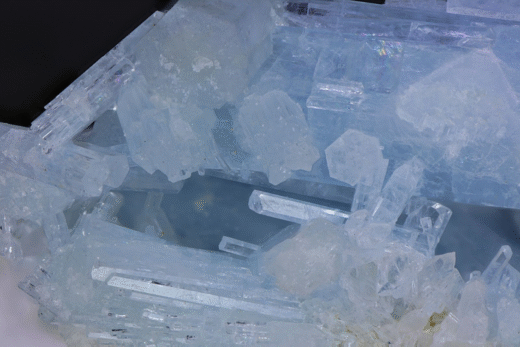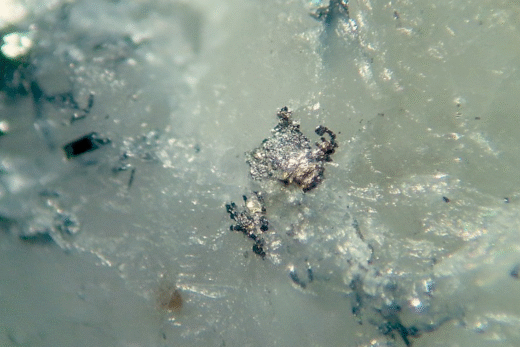Issue 26/1 of the Australian Journal of Mineralogy (AJM) is now out. This excellent publication comes out twice a year and is really good value for money at AU$35 per year in Australia, $44 New Zealand and Asia, and $49 for the rest of the world. You can find out how to subscribe on the AJM website.
This 72 page full colour issue has some excellent articles.
Morningstarite, Na(W₂.₆₇Fe³⁺₀.₃₃)O₉·H₂O, a new mineral with a tungsten-bronze-related structure, from the Bamford Hill mines, Mareeba Shire, Queensland
Peter Elliott, Ian E Grey, Anthony R Kampf and Colin M MacRae
Abstract
Morningstarite, Na(W₂.₆₇Fe³⁺₀.₃₃)O₉·H₂O, is a new secondary tungstate mineral from the Bamford Hill wolframite mines, Queensland. It occurs as microcrystalline, cream to orange-coloured, boxwork-like replacements of wolframite. Associated minerals are ootannite, russellite-koechlinite, goethite, kaolinite and a hydrokenoelsmoreite-related pyrochlore. The calculated density is 6.4 g·cm⁻³. Optically the crystals are uniaxial (–) with a mean calculated index of refraction of 2.14. Electron microprobe analyses gave the empirical formula
(Na₀.₄₃Pb₀.₀₃U⁶⁺₀.₂₅□₀.₂₉)Σ₁.₀₀(W₂.₃₀Fe³⁺₀.₄₂Al₀.₂₈)Σ₃.₀₀[O₈.₀₁(OH)₀.₉₉]Σ₉.₀₀·[(Oᵤᵣ)₀.₅₀(H₂O)₀.₃₇₅K₀.₁₂₅]Σ₁.₀₀, where Oᵤᵣ = uranyl oxygen. Morningstarite is hexagonal, space group P6/mmm, with unit-cell parameters a = 7.30124(16) Å, c = 3.89630(13) Å, V = 179.877(8) ų and Z = 1. The crystal structure was refined using the Rietveld method. It is a hexagonal-bronze type structure with tungsten, iron and aluminium occupying the octahedral sites and with sodium, potassium, lead and UO₂, occupying sites in the channels. Morningstarite is closely related to wumuite, K(W₂.₆₇Al₀.₃₃)O₉. Apart from the different chemistry, it differs from wumuite in having the tungsten atoms displaced from the centres of the octahedra to give alternating long and short (W=O) bonds along [001].
The Thomas Thomson mineral collection: its fortuitous journey from Glasgow to Melbourne via London
William D Birch and Thomas A Darragh
Abstract
Thomas Thomson, Professor of Chemistry at the University of Glasgow and pioneer mineralogist, put together a mineral collection to assist both his research in mineralogy and his teaching. On his death in 1852, the collection passed to his nephew and son-in-law, Robert Dundas Thomson, who became Lecturer in Chemistry at St Thomas’s Hospital, London. Following his resignation from that position, he arranged for the collection to be sold by the London auctioneer JC Stevens in February 1862. A significant part of the collection was purchased by William Vazie Simons, a former assistant to both Thomsons, who had spent the previous ten years in Bendigo, Victoria. Later in 1862, he brought the collection with him on his return to Melbourne. In 1865, after stints as lecturer, chemical analyst and wine dealer, he sold the collection to the Victorian Mining Department, which exhibited it at the 1866–1867 Intercolonial Exhibition in Melbourne. The collection later passed to the Industrial and Technological Museum of Victoria and then to the National Museum of Victoria and is now in Museums Victoria. Details of Simons’ life are given and the history of the collection traced, including claims made by the notorious John Calvert in 1890 that he had purchased the major portion of the collection. The Natural History Museum in London has an unknown number of Thomas Thomson specimens, but no Thomson specimens in Calvert’s former collection have been traced.
The mines and minerals of Chillagoe–Mungana District, North Queensland
John Haupt and Ian Hodkinson
Abstract
Little has been recorded of the minerals from the mines in the Chillagoe–Mungana District in North Queensland. The mines have an intriguing history involving Broken Hill directors and a legacy of overcapitalization and mismanagement by both company and government employees. In this area, Carboniferous–Permian epithermal and skarn-type copper, silver, lead, zinc and gold mineralization was produced by the intrusion of high-level rhyolitic porphyries into the host limestone and associated marine sedimentary rocks of the Silurian–Devonian Chillagoe Formation. The mines produced world class specimens of azurite, malachite, cuprite and native copper and specimens of many other secondary copper and silver–lead minerals within the oxidized zone.
Tumut illite
Peter G Self and Richard A Eggleton
Abstract
A collation of the properties of an Australian clay mineral standard, Tumut illite from the Talbingo Dam region of the Snowy Mountains in New South Wales, is presented. The physical and chemical properties of Tumut illite indicate that it follows Meunier and Velde’s (2004) proposal for illite and illitic minerals. The 0.5 – 2 µm material is, for all intents and purposes, an ‘end-member’ illite in that this material contains no expandable layers, has a layer charge of approximately 0.9 per O₁₀(OH)₂, and consists of 1M and 2M₁ polytypes. The <0.2 µm material contains expandable layers, has a low interlayer charge (<0.9 per O₁₀(OH)₂) and only contains material with a 1M structure. Therefore the <0.2 µm material should be described as illitic. The 0.2 – 0.5 µm material has similar characteristics to the 0.5 – 2 µm material but powder X-ray diffraction indicates that it may contain some expandable layers and hence, on that basis, should also be described as illitic.




